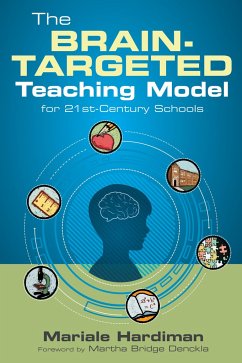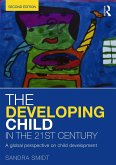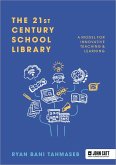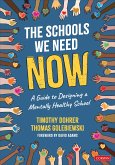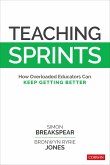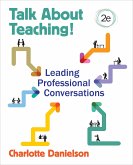Mariale M. Hardiman
The Brain-Targeted Teaching Model for 21st-Century Schools
Mariale M. Hardiman
The Brain-Targeted Teaching Model for 21st-Century Schools
- Broschiertes Buch
- Merkliste
- Auf die Merkliste
- Bewerten Bewerten
- Teilen
- Produkt teilen
- Produkterinnerung
- Produkterinnerung
This proven model for applying brain research for more effective instruction shows how to implement educational and cognitive neuroscience principles to classroom settings through a pedagogical framework.
Andere Kunden interessierten sich auch für
![The Daily Sel Leader The Daily Sel Leader]() James A. BaileyThe Daily Sel Leader25,99 €
James A. BaileyThe Daily Sel Leader25,99 €![The Developing Child in the 21st Century The Developing Child in the 21st Century]() Sandra SmidtThe Developing Child in the 21st Century66,99 €
Sandra SmidtThe Developing Child in the 21st Century66,99 €![The 21st Century School Library: A Model for Innovative Teaching & Learning The 21st Century School Library: A Model for Innovative Teaching & Learning]() Ryan Bani TahmasebThe 21st Century School Library: A Model for Innovative Teaching & Learning22,99 €
Ryan Bani TahmasebThe 21st Century School Library: A Model for Innovative Teaching & Learning22,99 €![Leading Schools in a Data-Rich World Leading Schools in a Data-Rich World]() L Earl / S KatzLeading Schools in a Data-Rich World26,99 €
L Earl / S KatzLeading Schools in a Data-Rich World26,99 €![The Schools We Need Now The Schools We Need Now]() Timothy DohrerThe Schools We Need Now26,99 €
Timothy DohrerThe Schools We Need Now26,99 €![Teaching Sprints Teaching Sprints]() Simon BreakspearTeaching Sprints31,99 €
Simon BreakspearTeaching Sprints31,99 €![Talk about Teaching! Talk about Teaching!]() Charlotte F. DanielsonTalk about Teaching!30,99 €
Charlotte F. DanielsonTalk about Teaching!30,99 €-
-
-
This proven model for applying brain research for more effective instruction shows how to implement educational and cognitive neuroscience principles to classroom settings through a pedagogical framework.
Produktdetails
- Produktdetails
- Verlag: SAGE Publications Inc
- Seitenzahl: 256
- Erscheinungstermin: 15. Februar 2012
- Englisch
- Abmessung: 254mm x 179mm x 20mm
- Gewicht: 550g
- ISBN-13: 9781412991988
- ISBN-10: 1412991986
- Artikelnr.: 34541521
- Herstellerkennzeichnung
- Libri GmbH
- Europaallee 1
- 36244 Bad Hersfeld
- gpsr@libri.de
- Verlag: SAGE Publications Inc
- Seitenzahl: 256
- Erscheinungstermin: 15. Februar 2012
- Englisch
- Abmessung: 254mm x 179mm x 20mm
- Gewicht: 550g
- ISBN-13: 9781412991988
- ISBN-10: 1412991986
- Artikelnr.: 34541521
- Herstellerkennzeichnung
- Libri GmbH
- Europaallee 1
- 36244 Bad Hersfeld
- gpsr@libri.de
Dr. Mariale M. Hardiman is Professor Emeritus at Johns Hopkins University in Baltimore, MD. Her work has contributed to advancing the field of neuroeducation through various roles including professor, researcher, school principal, consultant, and author of books, book chapters, journal articles, and multi-media presentations. She founded the Neuro-Education Initiative and the Mind, Brain, and Teaching programs at the Johns Hopkins University School of Education. Through academic courses and professional development, her work connects research from the learning sciences with teaching and learning strategies for professionals in education and related fields. She has conducted pioneering research on the effects of arts integration on long-term retention of academic content. She also examined how knowledge of the learning sciences influences teaching practices and efficacy beliefs. Her National Science Foundation-funded research investigated teachers' perception of creative thinking strategies and creativity assessments. Additionally, Hardiman's administrative roles at the Johns Hopkins School of Education include Department Chair, Vice Dean of Academic Affairs, and two appointments as Interim Dean. In her time as a school principal in Baltimore City, Hardiman developed a teaching framework, the Brain-Targeted Teaching® Model that promotes arts integration and creative problem-solving. Hardiman presents her work nationally and internationally on topics related to the intersection of research in the learning sciences with effective teaching, leading, and learning. Her research on arts integration has been featured in various popular news outlets including the New York Times, Forbes, Psychology Today, Pacific Standard and Southern Living. Hardiman can be reached at mmhardiman@jhu.edu Visit her website www.braintargetedteaching.org
List of Expert Teachers by Chapter
Foreword
Preface
Acknowledgments
About the Author
Introduction: The Emerging Field of Neuroeducation and 21st Century Schools
1. Information from the Neuro- and Cognitive Sciences that Educators Should
Know-Separating Neuromyth from Neuroscience
2. Brain Structure and Function
Brain Facts
Brain Cells: Neurons and Glial Cells
Cerebral Organization
Hemispheric Difference
From Research to Practice
3. The Brain-Targeted Teaching Model for 21st Century Schools
Overview of the Brain-Targeted Teaching Model
Brain Target One: Establishing the Emotional Climate for Learning
Brain Target Two: Creating the Physical Learning Environment
Brain Target Three: Designing the Learning Experience
Brain Target Four: Teaching for Mastery of Content, Skills, and Concepts
Brain Target Five: Teaching for the Extension and Application of
Knowledge-Creativity and Innovation in Education
Brain Target Six: Evaluating Learning
Brain-Targeted Teaching: Research to Practice
4. Brain-Target One: Establishing the Emotional Climate for Learning
Neural Systems Underlying Emotion
How We Perceive Fear and Threat
Effects of Stress on Learning
Stress and School Environments
The Impact of Positive Emotions
Emotions and the Adolescent
Implementing Brain Target One: Establishing the Emotional Climate for
Learning
Strategies for Promoting a Positive Learning Environment
Emotional Connection to Learning Goals and Objectives
What Does a Brain-Targeted Teaching Unit Look Like in the Classroom?
5. Brain-Target Two: Creating the Physical Learning Environment
Attention and Novelty
Lighting in the Classroom
Sound in the Learning Environment
Scent in the Classroom
The Effects of Movement on Attention
Order and Beauty in the Classroom
What Does a Brain-Targeted Teaching Unit Look Like in the Classroom?
6. Brain-Target Three: Designing the Learning Experience
Cognitive Development and Big Picture Thinking
Cognitive Development and Big Picture Thinking
Instructional Decision-Making: Content Choices for Learning Goals and
Objectives
Learning Activities
Evaluating Learning
Use of Graphic Organizers in the Brain-Targeted Teaching Model
What Does a Brain-Targeted Teaching Unit Look Like in the Classroom?
7. Brain Target Four: Teaching for Mastery of Content, Skills, and Concepts
Learning and Memory
Types of Memory Processes
Neurobiology of Learning and Memory
Arts Integration for Mastery of Content, Skills, and Concepts
Repeated Rehearsal
Elaboration
Generation
Enactment
Production
Effort After Meaning
Pictorial Representation
Emotion and Memory
Mnemonics
Desirable Difficulties
Chunking
Interleaving
Brain-Targeted Teaching Learning Units
What Does a Brain-Targeted Teaching Unit Look Like in the Classroom?
8. Brain Target Five: Teaching for the Extension and Application of
Knowledge-Creativity and Innovation in Education
Twenty-First Century Skills
Creativity and Innovation in the Classroom
What Do the Brain Sciences Tell Us About Higher-Order Thinking and
Creativity?
Content versus Process in the 21st Century Skills Movement
What Does This Mean for Teachers?
Brain Target Five Activities
Brain Target Five Summary
What Does a Brain-Targeted Teaching Unit Look Like in the Classroom?
9. Brain-Target Six: Evaluating Learning
Research to Practice: Evaluation to Enhance Learning
Frequent and Timely Feedback
Active Retrieval of Information
Spacing Effects
Multiple Kinds of Assessments
Portfolio Assessments
Student Journals
Performance Assessments
What Does a Brain-Targeted Teaching Unit Look Like in the Classroom?
10. Implementing Brain-Targeted Teaching in a School and Classroom
Brain-Targeted Teaching in the School: Getting Started
Instructional Leadership and Support
What Does a School Implementing Brain-Targeted Teaching Look Like?
Brain Target One: Emotional Climate for Learning
Brain Target Two: Physical Environment
Brain Target Three: Learning Design
Brain Target Four: Teaching for Mastery of Content, Skills, and Concepts
Brain Target Five: Teaching for the Extension and Application of Knowledge:
Creativity and Innovation in Education
Brain Target Six: Evaluating Learning
Brain-Targeted Teaching in Teacher Preparation Programs: A Story from a
Teacher Educator
APPENDIX I
Alignment of Brain-Targeted Teaching with Cognitive Taxonomies, Teaching
Standards and Frameworks
Cognitive Taxonomies
Brain-Targeted Teaching Alignment
Teaching Standards and Teaching and Learning Frameworks
APPENDIX II
Brain-Targeted Teaching Implementation Checklist
Index
Foreword
Preface
Acknowledgments
About the Author
Introduction: The Emerging Field of Neuroeducation and 21st Century Schools
1. Information from the Neuro- and Cognitive Sciences that Educators Should
Know-Separating Neuromyth from Neuroscience
2. Brain Structure and Function
Brain Facts
Brain Cells: Neurons and Glial Cells
Cerebral Organization
Hemispheric Difference
From Research to Practice
3. The Brain-Targeted Teaching Model for 21st Century Schools
Overview of the Brain-Targeted Teaching Model
Brain Target One: Establishing the Emotional Climate for Learning
Brain Target Two: Creating the Physical Learning Environment
Brain Target Three: Designing the Learning Experience
Brain Target Four: Teaching for Mastery of Content, Skills, and Concepts
Brain Target Five: Teaching for the Extension and Application of
Knowledge-Creativity and Innovation in Education
Brain Target Six: Evaluating Learning
Brain-Targeted Teaching: Research to Practice
4. Brain-Target One: Establishing the Emotional Climate for Learning
Neural Systems Underlying Emotion
How We Perceive Fear and Threat
Effects of Stress on Learning
Stress and School Environments
The Impact of Positive Emotions
Emotions and the Adolescent
Implementing Brain Target One: Establishing the Emotional Climate for
Learning
Strategies for Promoting a Positive Learning Environment
Emotional Connection to Learning Goals and Objectives
What Does a Brain-Targeted Teaching Unit Look Like in the Classroom?
5. Brain-Target Two: Creating the Physical Learning Environment
Attention and Novelty
Lighting in the Classroom
Sound in the Learning Environment
Scent in the Classroom
The Effects of Movement on Attention
Order and Beauty in the Classroom
What Does a Brain-Targeted Teaching Unit Look Like in the Classroom?
6. Brain-Target Three: Designing the Learning Experience
Cognitive Development and Big Picture Thinking
Cognitive Development and Big Picture Thinking
Instructional Decision-Making: Content Choices for Learning Goals and
Objectives
Learning Activities
Evaluating Learning
Use of Graphic Organizers in the Brain-Targeted Teaching Model
What Does a Brain-Targeted Teaching Unit Look Like in the Classroom?
7. Brain Target Four: Teaching for Mastery of Content, Skills, and Concepts
Learning and Memory
Types of Memory Processes
Neurobiology of Learning and Memory
Arts Integration for Mastery of Content, Skills, and Concepts
Repeated Rehearsal
Elaboration
Generation
Enactment
Production
Effort After Meaning
Pictorial Representation
Emotion and Memory
Mnemonics
Desirable Difficulties
Chunking
Interleaving
Brain-Targeted Teaching Learning Units
What Does a Brain-Targeted Teaching Unit Look Like in the Classroom?
8. Brain Target Five: Teaching for the Extension and Application of
Knowledge-Creativity and Innovation in Education
Twenty-First Century Skills
Creativity and Innovation in the Classroom
What Do the Brain Sciences Tell Us About Higher-Order Thinking and
Creativity?
Content versus Process in the 21st Century Skills Movement
What Does This Mean for Teachers?
Brain Target Five Activities
Brain Target Five Summary
What Does a Brain-Targeted Teaching Unit Look Like in the Classroom?
9. Brain-Target Six: Evaluating Learning
Research to Practice: Evaluation to Enhance Learning
Frequent and Timely Feedback
Active Retrieval of Information
Spacing Effects
Multiple Kinds of Assessments
Portfolio Assessments
Student Journals
Performance Assessments
What Does a Brain-Targeted Teaching Unit Look Like in the Classroom?
10. Implementing Brain-Targeted Teaching in a School and Classroom
Brain-Targeted Teaching in the School: Getting Started
Instructional Leadership and Support
What Does a School Implementing Brain-Targeted Teaching Look Like?
Brain Target One: Emotional Climate for Learning
Brain Target Two: Physical Environment
Brain Target Three: Learning Design
Brain Target Four: Teaching for Mastery of Content, Skills, and Concepts
Brain Target Five: Teaching for the Extension and Application of Knowledge:
Creativity and Innovation in Education
Brain Target Six: Evaluating Learning
Brain-Targeted Teaching in Teacher Preparation Programs: A Story from a
Teacher Educator
APPENDIX I
Alignment of Brain-Targeted Teaching with Cognitive Taxonomies, Teaching
Standards and Frameworks
Cognitive Taxonomies
Brain-Targeted Teaching Alignment
Teaching Standards and Teaching and Learning Frameworks
APPENDIX II
Brain-Targeted Teaching Implementation Checklist
Index
List of Expert Teachers by Chapter
Foreword
Preface
Acknowledgments
About the Author
Introduction: The Emerging Field of Neuroeducation and 21st Century Schools
1. Information from the Neuro- and Cognitive Sciences that Educators Should
Know-Separating Neuromyth from Neuroscience
2. Brain Structure and Function
Brain Facts
Brain Cells: Neurons and Glial Cells
Cerebral Organization
Hemispheric Difference
From Research to Practice
3. The Brain-Targeted Teaching Model for 21st Century Schools
Overview of the Brain-Targeted Teaching Model
Brain Target One: Establishing the Emotional Climate for Learning
Brain Target Two: Creating the Physical Learning Environment
Brain Target Three: Designing the Learning Experience
Brain Target Four: Teaching for Mastery of Content, Skills, and Concepts
Brain Target Five: Teaching for the Extension and Application of
Knowledge-Creativity and Innovation in Education
Brain Target Six: Evaluating Learning
Brain-Targeted Teaching: Research to Practice
4. Brain-Target One: Establishing the Emotional Climate for Learning
Neural Systems Underlying Emotion
How We Perceive Fear and Threat
Effects of Stress on Learning
Stress and School Environments
The Impact of Positive Emotions
Emotions and the Adolescent
Implementing Brain Target One: Establishing the Emotional Climate for
Learning
Strategies for Promoting a Positive Learning Environment
Emotional Connection to Learning Goals and Objectives
What Does a Brain-Targeted Teaching Unit Look Like in the Classroom?
5. Brain-Target Two: Creating the Physical Learning Environment
Attention and Novelty
Lighting in the Classroom
Sound in the Learning Environment
Scent in the Classroom
The Effects of Movement on Attention
Order and Beauty in the Classroom
What Does a Brain-Targeted Teaching Unit Look Like in the Classroom?
6. Brain-Target Three: Designing the Learning Experience
Cognitive Development and Big Picture Thinking
Cognitive Development and Big Picture Thinking
Instructional Decision-Making: Content Choices for Learning Goals and
Objectives
Learning Activities
Evaluating Learning
Use of Graphic Organizers in the Brain-Targeted Teaching Model
What Does a Brain-Targeted Teaching Unit Look Like in the Classroom?
7. Brain Target Four: Teaching for Mastery of Content, Skills, and Concepts
Learning and Memory
Types of Memory Processes
Neurobiology of Learning and Memory
Arts Integration for Mastery of Content, Skills, and Concepts
Repeated Rehearsal
Elaboration
Generation
Enactment
Production
Effort After Meaning
Pictorial Representation
Emotion and Memory
Mnemonics
Desirable Difficulties
Chunking
Interleaving
Brain-Targeted Teaching Learning Units
What Does a Brain-Targeted Teaching Unit Look Like in the Classroom?
8. Brain Target Five: Teaching for the Extension and Application of
Knowledge-Creativity and Innovation in Education
Twenty-First Century Skills
Creativity and Innovation in the Classroom
What Do the Brain Sciences Tell Us About Higher-Order Thinking and
Creativity?
Content versus Process in the 21st Century Skills Movement
What Does This Mean for Teachers?
Brain Target Five Activities
Brain Target Five Summary
What Does a Brain-Targeted Teaching Unit Look Like in the Classroom?
9. Brain-Target Six: Evaluating Learning
Research to Practice: Evaluation to Enhance Learning
Frequent and Timely Feedback
Active Retrieval of Information
Spacing Effects
Multiple Kinds of Assessments
Portfolio Assessments
Student Journals
Performance Assessments
What Does a Brain-Targeted Teaching Unit Look Like in the Classroom?
10. Implementing Brain-Targeted Teaching in a School and Classroom
Brain-Targeted Teaching in the School: Getting Started
Instructional Leadership and Support
What Does a School Implementing Brain-Targeted Teaching Look Like?
Brain Target One: Emotional Climate for Learning
Brain Target Two: Physical Environment
Brain Target Three: Learning Design
Brain Target Four: Teaching for Mastery of Content, Skills, and Concepts
Brain Target Five: Teaching for the Extension and Application of Knowledge:
Creativity and Innovation in Education
Brain Target Six: Evaluating Learning
Brain-Targeted Teaching in Teacher Preparation Programs: A Story from a
Teacher Educator
APPENDIX I
Alignment of Brain-Targeted Teaching with Cognitive Taxonomies, Teaching
Standards and Frameworks
Cognitive Taxonomies
Brain-Targeted Teaching Alignment
Teaching Standards and Teaching and Learning Frameworks
APPENDIX II
Brain-Targeted Teaching Implementation Checklist
Index
Foreword
Preface
Acknowledgments
About the Author
Introduction: The Emerging Field of Neuroeducation and 21st Century Schools
1. Information from the Neuro- and Cognitive Sciences that Educators Should
Know-Separating Neuromyth from Neuroscience
2. Brain Structure and Function
Brain Facts
Brain Cells: Neurons and Glial Cells
Cerebral Organization
Hemispheric Difference
From Research to Practice
3. The Brain-Targeted Teaching Model for 21st Century Schools
Overview of the Brain-Targeted Teaching Model
Brain Target One: Establishing the Emotional Climate for Learning
Brain Target Two: Creating the Physical Learning Environment
Brain Target Three: Designing the Learning Experience
Brain Target Four: Teaching for Mastery of Content, Skills, and Concepts
Brain Target Five: Teaching for the Extension and Application of
Knowledge-Creativity and Innovation in Education
Brain Target Six: Evaluating Learning
Brain-Targeted Teaching: Research to Practice
4. Brain-Target One: Establishing the Emotional Climate for Learning
Neural Systems Underlying Emotion
How We Perceive Fear and Threat
Effects of Stress on Learning
Stress and School Environments
The Impact of Positive Emotions
Emotions and the Adolescent
Implementing Brain Target One: Establishing the Emotional Climate for
Learning
Strategies for Promoting a Positive Learning Environment
Emotional Connection to Learning Goals and Objectives
What Does a Brain-Targeted Teaching Unit Look Like in the Classroom?
5. Brain-Target Two: Creating the Physical Learning Environment
Attention and Novelty
Lighting in the Classroom
Sound in the Learning Environment
Scent in the Classroom
The Effects of Movement on Attention
Order and Beauty in the Classroom
What Does a Brain-Targeted Teaching Unit Look Like in the Classroom?
6. Brain-Target Three: Designing the Learning Experience
Cognitive Development and Big Picture Thinking
Cognitive Development and Big Picture Thinking
Instructional Decision-Making: Content Choices for Learning Goals and
Objectives
Learning Activities
Evaluating Learning
Use of Graphic Organizers in the Brain-Targeted Teaching Model
What Does a Brain-Targeted Teaching Unit Look Like in the Classroom?
7. Brain Target Four: Teaching for Mastery of Content, Skills, and Concepts
Learning and Memory
Types of Memory Processes
Neurobiology of Learning and Memory
Arts Integration for Mastery of Content, Skills, and Concepts
Repeated Rehearsal
Elaboration
Generation
Enactment
Production
Effort After Meaning
Pictorial Representation
Emotion and Memory
Mnemonics
Desirable Difficulties
Chunking
Interleaving
Brain-Targeted Teaching Learning Units
What Does a Brain-Targeted Teaching Unit Look Like in the Classroom?
8. Brain Target Five: Teaching for the Extension and Application of
Knowledge-Creativity and Innovation in Education
Twenty-First Century Skills
Creativity and Innovation in the Classroom
What Do the Brain Sciences Tell Us About Higher-Order Thinking and
Creativity?
Content versus Process in the 21st Century Skills Movement
What Does This Mean for Teachers?
Brain Target Five Activities
Brain Target Five Summary
What Does a Brain-Targeted Teaching Unit Look Like in the Classroom?
9. Brain-Target Six: Evaluating Learning
Research to Practice: Evaluation to Enhance Learning
Frequent and Timely Feedback
Active Retrieval of Information
Spacing Effects
Multiple Kinds of Assessments
Portfolio Assessments
Student Journals
Performance Assessments
What Does a Brain-Targeted Teaching Unit Look Like in the Classroom?
10. Implementing Brain-Targeted Teaching in a School and Classroom
Brain-Targeted Teaching in the School: Getting Started
Instructional Leadership and Support
What Does a School Implementing Brain-Targeted Teaching Look Like?
Brain Target One: Emotional Climate for Learning
Brain Target Two: Physical Environment
Brain Target Three: Learning Design
Brain Target Four: Teaching for Mastery of Content, Skills, and Concepts
Brain Target Five: Teaching for the Extension and Application of Knowledge:
Creativity and Innovation in Education
Brain Target Six: Evaluating Learning
Brain-Targeted Teaching in Teacher Preparation Programs: A Story from a
Teacher Educator
APPENDIX I
Alignment of Brain-Targeted Teaching with Cognitive Taxonomies, Teaching
Standards and Frameworks
Cognitive Taxonomies
Brain-Targeted Teaching Alignment
Teaching Standards and Teaching and Learning Frameworks
APPENDIX II
Brain-Targeted Teaching Implementation Checklist
Index

